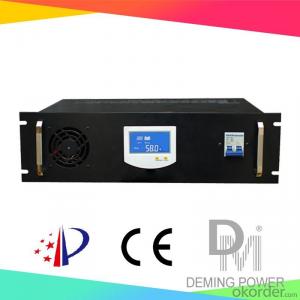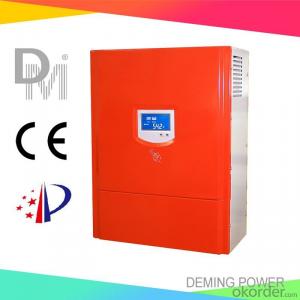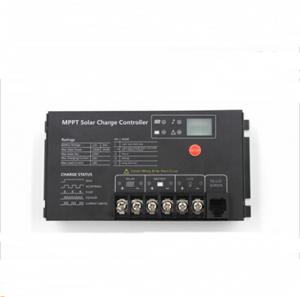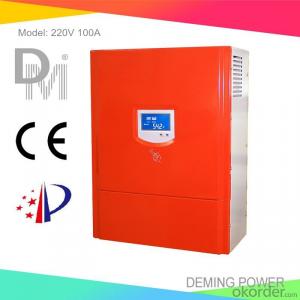MPPT Solar Charge Controller 96V 60A for off grid solar power system and RS485 available
- Loading Port:
- Qingdao
- Payment Terms:
- TT OR LC
- Min Order Qty:
- 1 PCS
- Supply Capability:
- 1000 PCS/month
OKorder Service Pledge
OKorder Financial Service
You Might Also Like
Properties of the solar charge controller
1. Design for off-grid solar power system.
2. Applicable to different kinds of batteries.
3. Adopts MPPT technology (Maximum Power Point Tracking). The advanced tracking algorithm make the solar module operate at ideal voltage which the solar modules can produce the maximum available power.
4. Modular design with simple structure and easy maintenance.
5. Automatic power control function.
6. LCD display: Solar panel current, solar panel voltage, solar panel power, battery group voltage, charge current.
7. Perfect protection function: Solar reverse charge protection, Solar reverse connection protection, Battery reverse connection protection, Battery overcharge protection, Battery over current protection etc ,thus the system has higher reliability.
Technical parameters of the solar charge controller
Model | 96V60A | ||
Battery group rated voltage | 96Vdc | ||
PV Rated current | 60A | ||
PV open circuit voltage | 400V | ||
PV Max. power | 5760Wp | ||
MPPT input DC voltage rang | 80-116Vdc | ||
Input PV module road number | 1 | ||
Function | MPPT charge mode, auto stop charge, auto recharge voltage; Protection: connecting contrary, over current, short circuit, over heat etc. | ||
Display mode | LCD | ||
Display content | solar panel voltage, solar panel current, solar panel power, battery voltage, charge current | ||
Floating Charge Voltage (adjustable) | 110Vdc | ||
Stop charge voltage | 116Vdc±2% | ||
Recharge voltage | 108V±2% | ||
Voltage drop between PV and battery | 1.5V | ||
Max itself power consumption | 100mA-150mA | ||
Work environment temperature | -30-60°C | ||
Relative humidity | 90% No condensation | ||
Applicable altitude | 3000m The rated power should be reduced when it is higher than 2000m | ||
Noise (1m) | 40dB | ||
Degree of protection | IP20(Indoor) | ||
Cooling method | Forced air cooling | ||
*Communication interface (optional) | RS485/USB | ||
*Temperature compensation(optional) | -4mv/°C/2V,-35°C~+80°C,Accuracy:±1°C | ||
Product size (mm) | 520*430*200mm, 480*360*150mm | ||
Weight(kg) | 13Kg, 18kg | ||
*Above parameter only for reference. Could be custom made to user specifications.
- Q:Can a solar controller be used with a solar water pumping system?
- Yes, a solar controller can be used with a solar water pumping system. A solar controller helps regulate and control the power output from the solar panels to the pump, ensuring efficient operation and protection against overcharging or damage to the system. It helps optimize the performance of the solar water pumping system by managing the flow of electricity and protecting the batteries, allowing for reliable and sustainable water pumping.
- Q:Can a solar controller be used with solar-powered lighting systems?
- Yes, a solar controller can definitely be used with solar-powered lighting systems. A solar controller helps regulate the charging and discharging of batteries in the lighting system, ensuring optimal performance and prolonging battery life. It also provides important features like overcharge protection, load control, and battery status monitoring, making it an essential component for efficient and reliable operation of solar-powered lighting systems.
- Q:Can a solar controller be used with flooded batteries?
- Yes, a solar controller can be used with flooded batteries. In fact, it is recommended to use a solar controller with flooded batteries to ensure proper charging and prevent overcharging, which can damage the batteries. The solar controller regulates the charging current and voltage from the solar panels, protecting the flooded batteries and extending their lifespan.
- Q:What is the maximum voltage drop allowed between the solar panels and the batteries?
- The maximum voltage drop allowed between the solar panels and the batteries depends on the specific system and its components. Generally, it is recommended to keep the voltage drop as low as possible, ideally below 3% to ensure efficient power transfer and minimize energy loss. However, it is best to consult the manufacturer's specifications and guidelines for the specific solar panels and batteries being used to determine the maximum allowable voltage drop.
- Q:How does a solar controller prevent short circuits in the solar panel system?
- A solar controller, also known as a charge controller, plays a crucial role in preventing short circuits in a solar panel system. It acts as a middleman between the solar panels and the battery or load, ensuring that the flow of electricity is regulated and controlled. One of the main functions of a solar controller is to regulate the charging process of the battery. It monitors the voltage and current levels from the solar panels and ensures that the battery is charged within safe limits. By carefully managing the charging process, it prevents any excessive flow of electricity that could potentially cause a short circuit. Additionally, a solar controller incorporates various protective features to prevent short circuits. It typically includes circuit breakers or fuses that act as safeguards in case of any electrical faults. These protective devices are designed to interrupt the flow of electricity in case of an overcurrent situation, preventing any damage or short circuit in the system. Furthermore, solar controllers often have built-in mechanisms to protect against reverse current flow. During the night or in low light conditions when the solar panels are not generating power, the controller ensures that the battery's current does not flow back into the panels, which could cause a short circuit. By preventing reverse current flow, the controller safeguards the system from potential electrical faults. Overall, a solar controller plays a vital role in preventing short circuits in a solar panel system by regulating the charging process, incorporating protective features like circuit breakers or fuses, and preventing reverse current flow. Its primary objective is to maintain a safe and efficient flow of electricity, ensuring the longevity and reliability of the entire solar panel system.
- Q:Can a solar controller be used with solar panels that are not facing directly towards the sun?
- Yes, a solar controller can still be used with solar panels that are not facing directly towards the sun. The purpose of a solar controller is to regulate and optimize the charging process of the batteries connected to the solar panels. While direct sunlight is ideal for maximum energy production, solar panels can still generate electricity even when not facing directly towards the sun. The solar controller will ensure that the energy harvested from the panels is efficiently stored in the batteries, regardless of the panel's angle towards the sun.
- Q:How does a solar controller handle high current flow from the solar panels?
- A solar controller, also known as a charge controller, plays a crucial role in regulating the flow of current from the solar panels to the battery bank. It ensures that the batteries receive the correct amount of charge and prevents overcharging or damage to the batteries. When high current flows from the solar panels, the solar controller manages this by utilizing a few key mechanisms. Firstly, it employs a pulse width modulation (PWM) or maximum power point tracking (MPPT) technique to efficiently convert the high current generated by the solar panels into the appropriate voltage and current required for charging the batteries. In the case of a PWM controller, it rapidly switches the connection between the solar panels and the battery bank on and off, controlling the flow of current and voltage to match the battery's requirements. This method effectively regulates the charging process and prevents excessive current from reaching the batteries. On the other hand, MPPT controllers employ advanced algorithms and circuitry to track the maximum power point of the solar panels, optimizing the energy conversion process. These controllers can handle high current flow by adjusting the voltage and current to maintain the maximum power output from the panels, resulting in more efficient charging of the batteries. Additionally, solar controllers incorporate various safety features to handle high current flow. They typically have built-in protections such as overcharge protection, short-circuit protection, and reverse polarity protection. These safeguards ensure the system remains safe and prevents any damage to the solar panels, batteries, or other connected components. In summary, a solar controller effectively handles high current flow from the solar panels through techniques such as PWM or MPPT, optimizing the energy conversion process. It also incorporates safety features to protect the system and ensure the batteries receive the appropriate charge without any risk of damage.
- Q:Are there any energy-saving features in a solar controller?
- Solar controllers typically have various energy-saving features. One notable feature is their ability to regulate and optimize battery charging in the solar system. This ensures efficient charging, preventing overcharging and extending battery lifespan. Additionally, solar controllers often include a low voltage disconnect (LVD) feature. When the battery voltage drops below a certain level, the load automatically disconnects to prevent excessive discharge, which can harm the batteries. Some advanced solar controllers even have maximum power point tracking (MPPT) technology. This technology continuously adjusts voltage and current to match ideal operating conditions, maximizing energy harvested from the solar panels. As a result, the overall energy efficiency of the solar system is significantly improved.
- Q:How do I connect multiple solar controllers together?
- In order to connect multiple solar controllers together, there are a few steps that need to be followed. Firstly, it is crucial to identify the type of solar controllers you have. Before connecting them, it is important to ensure that they are compatible with each other. Take a look at the specifications and features of each controller to verify whether they can be connected in parallel or series. Next, determine the connection method that will be used. There are two common methods - parallel and series. In parallel connection, the positive terminals of all controllers are connected together, as well as the negative terminals. On the other hand, in series connection, the positive terminal of one controller is connected to the negative terminal of the next controller. Once the appropriate connection method has been determined, proceed with connecting the solar controllers. It is imperative to make sure that all connections are secure and tight to avoid any loose connections or electrical faults. Use appropriate wiring and connectors based on the size and type of the controllers. After physically connecting the controllers, there may be a need to configure some settings for them to work efficiently together. Refer to the user manuals or documentation provided with the controllers to understand how to correctly configure them. This may involve adjusting charging parameters, setting priority modes, or synchronizing the controllers. Once the controllers are connected and configured, it is essential to monitor their performance and test their functionality. Keep an eye on the charging and discharging patterns, battery voltage, and any error messages or alarms. Regularly check the system to ensure that all controllers are functioning correctly and charging the batteries effectively. It is important to remember that if there is any uncertainty about connecting solar controllers together, it is always advisable to consult a professional or refer to the manufacturer's guidance. Safety should always be a priority when dealing with electrical connections, especially in solar power systems.
- Q:What is the lifespan of a solar controller?
- The lifespan of a solar controller can vary depending on factors such as quality, usage, and maintenance. However, on average, a well-maintained solar controller can last anywhere between 5 to 15 years.
1. Manufacturer Overview |
|
|---|---|
| Location | |
| Year Established | |
| Annual Output Value | |
| Main Markets | |
| Company Certifications | |
2. Manufacturer Certificates |
|
|---|---|
| a) Certification Name | |
| Range | |
| Reference | |
| Validity Period | |
3. Manufacturer Capability |
|
|---|---|
| a)Trade Capacity | |
| Nearest Port | |
| Export Percentage | |
| No.of Employees in Trade Department | |
| Language Spoken: | |
| b)Factory Information | |
| Factory Size: | |
| No. of Production Lines | |
| Contract Manufacturing | |
| Product Price Range | |
Send your message to us
MPPT Solar Charge Controller 96V 60A for off grid solar power system and RS485 available
- Loading Port:
- Qingdao
- Payment Terms:
- TT OR LC
- Min Order Qty:
- 1 PCS
- Supply Capability:
- 1000 PCS/month
OKorder Service Pledge
OKorder Financial Service
Similar products
New products
Hot products
Hot Searches
Related keywords































